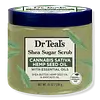What's inside
What's inside
 Key Ingredients
Key Ingredients

 Benefits
Benefits

 Concerns
Concerns

 Ingredients Side-by-side
Ingredients Side-by-side

Water
Skin ConditioningPumice
AbrasiveStearic Acid
CleansingCetearyl Alcohol
EmollientGlycolic Acid
BufferingSodium Hydroxide
BufferingGlycerin
HumectantSodium Cocoyl Isethionate
CleansingDimethicone
EmollientCocos Nucifera Oil
MaskingGlycine Soja Oil
EmollientCharcoal Powder
AbrasiveMicrocrystalline Cellulose
AbsorbentMannitol
HumectantZea Mays Starch
AbsorbentSodium Hyaluronate
HumectantAleurites Moluccanus Seed Oil
Skin ConditioningMacadamia Ternifolia Seed Oil
EmollientNiacinamide
SmoothingVolcanic Sand
Skin ConditioningLeuconostoc/Radish Root Ferment Filtrate
AntimicrobialKappaphycus Alvarezii Extract
Skin ConditioningAvena Sativa Kernel Flour
AbrasiveC12-15 Alkyl Benzoate
AntimicrobialSalix Nigra Bark Extract
Skin ProtectingLactic Acid
BufferingSea Water
HumectantCamellia Sinensis Leaf Extract
AntimicrobialGlycyrrhiza Glabra Root Extract
BleachingXanthan Gum
EmulsifyingSteareth-20
CleansingSteareth-21
CleansingEthylhexylglycerin
Skin ConditioningCaramel
Cosmetic ColorantTetrasodium Glutamate Diacetate
Tocopherol
AntioxidantPhenoxyethanol
PreservativeSodium Benzoate
MaskingPotassium Sorbate
PreservativeWater, Pumice, Stearic Acid, Cetearyl Alcohol, Glycolic Acid, Sodium Hydroxide, Glycerin, Sodium Cocoyl Isethionate, Dimethicone, Cocos Nucifera Oil, Glycine Soja Oil, Charcoal Powder, Microcrystalline Cellulose, Mannitol, Zea Mays Starch, Sodium Hyaluronate, Aleurites Moluccanus Seed Oil, Macadamia Ternifolia Seed Oil, Niacinamide, Volcanic Sand, Leuconostoc/Radish Root Ferment Filtrate, Kappaphycus Alvarezii Extract, Avena Sativa Kernel Flour, C12-15 Alkyl Benzoate, Salix Nigra Bark Extract, Lactic Acid, Sea Water, Camellia Sinensis Leaf Extract, Glycyrrhiza Glabra Root Extract, Xanthan Gum, Steareth-20, Steareth-21, Ethylhexylglycerin, Caramel, Tetrasodium Glutamate Diacetate, Tocopherol, Phenoxyethanol, Sodium Benzoate, Potassium Sorbate
Sucrose
HumectantGlycerin
HumectantSorbitol
HumectantWater
Skin ConditioningPolysorbate 20
EmulsifyingSilica
AbrasiveParfum
MaskingCitrus Aurantium Bergamia Fruit Oil
MaskingJuniperus Mexicana Oil
MaskingCitrus Aurantium Dulcis Peel Oil
MaskingButyrospermum Parkii Butter
Skin ConditioningCannabis Sativa Seed Oil
EmollientPersea Gratissima Oil
Skin ConditioningCitrus Sinensis Peel Oil Expressed
PerfumingOenothera Biennis Oil
EmollientMacadamia Ternifolia Seed Oil
EmollientPrunus Amygdalus Dulcis Oil
Skin ConditioningCarthamus Tinctorius Seed Oil
MaskingCocos Nucifera Oil
MaskingRetinyl Palmitate
Skin ConditioningAscorbic Acid
AntioxidantSorbic Acid
PreservativePhenoxyethanol
PreservativeEthylhexylglycerin
Skin ConditioningCI 19140
Cosmetic ColorantCI 42090
Cosmetic ColorantCI 17200
Cosmetic ColorantSucrose, Glycerin, Sorbitol, Water, Polysorbate 20, Silica, Parfum, Citrus Aurantium Bergamia Fruit Oil, Juniperus Mexicana Oil, Citrus Aurantium Dulcis Peel Oil, Butyrospermum Parkii Butter, Cannabis Sativa Seed Oil, Persea Gratissima Oil, Citrus Sinensis Peel Oil Expressed, Oenothera Biennis Oil, Macadamia Ternifolia Seed Oil, Prunus Amygdalus Dulcis Oil, Carthamus Tinctorius Seed Oil, Cocos Nucifera Oil, Retinyl Palmitate, Ascorbic Acid, Sorbic Acid, Phenoxyethanol, Ethylhexylglycerin, CI 19140, CI 42090, CI 17200
Ingredients Explained
These ingredients are found in both products.
Ingredients higher up in an ingredient list are typically present in a larger amount.
Cocos Nucifera Oil is obtained from the kernels of the coconut fruit. In other words, this is coconut oil.
Coconut Oil is rich in fatty acids with lauric acid making up the majority of these. It also contains linoleic acid. Due to this high fatty acid content, coconut oil helps trap moisture and soften skin.
Despite being antibacterial, coconut oil may not be great for acne-prone skin. It is comedogenic and may clog pores. This ingredient may not be safe for malassezia or fungal acne.
Note: Coconut Oil should not replace your sunscreen for UV protection. Studies show it only blocks about 20% of UV.
This oil is non-volatile and has a light scent.
The term 'fragrance' is not regulated in many countries. In many cases, it is up to the brand to define this term. For instance, many brands choose to label themselves as "fragrance-free" because they are not using synthetic fragrances. However, their products may still contain ingredients such as essential oils that are considered a fragrance.
Learn more about Cocos Nucifera OilEthylhexylglycerin (we can't pronounce this either) is commonly used as a preservative and skin softener. It is derived from glyceryl.
You might see Ethylhexylglycerin often paired with other preservatives such as phenoxyethanol. Ethylhexylglycerin has been found to increase the effectiveness of these other preservatives.
Glycerin is already naturally found in your skin. It helps moisturize and protect your skin.
A study from 2016 found glycerin to be more effective as a humectant than AHAs and hyaluronic acid.
As a humectant, it helps the skin stay hydrated by pulling moisture to your skin. The low molecular weight of glycerin allows it to pull moisture into the deeper layers of your skin.
Hydrated skin improves your skin barrier; Your skin barrier helps protect against irritants and bacteria.
Glycerin has also been found to have antimicrobial and antiviral properties. Due to these properties, glycerin is often used in wound and burn treatments.
In cosmetics, glycerin is usually derived from plants such as soybean or palm. However, it can also be sourced from animals, such as tallow or animal fat.
This ingredient is organic, colorless, odorless, and non-toxic.
Glycerin is the name for this ingredient in American English. British English uses Glycerol/Glycerine.
Learn more about GlycerinMacadamia Ternifolia Seed Oil is the fixed oil obtained from Macadamia nut.
Macadamia seed oil is rich in fatty acids, including oleic acid (45-75%), palmitoleic acid (7-33%), and palmitic acid (6-12%). They also contain various B vitamins, iron, and magnesium.
Palmitoleic acid has been shown to help soothe inflammation and promote wound healing. It is also naturally found in the fat of our skin.
Macadamia seed oil may not be malassezia folliculitis, or fungal-acne, safe.
Learn more about Macadamia Ternifolia Seed OilPhenoxyethanol is a preservative that has germicide, antimicrobial, and aromatic properties. Studies show that phenoxyethanol can prevent microbial growth. By itself, it has a scent that is similar to that of a rose.
It's often used in formulations along with Caprylyl Glycol to preserve the shelf life of products.
Water. It's the most common cosmetic ingredient of all. You'll usually see it at the top of ingredient lists, meaning that it makes up the largest part of the product.
So why is it so popular? Water most often acts as a solvent - this means that it helps dissolve other ingredients into the formulation.
You'll also recognize water as that liquid we all need to stay alive. If you see this, drink a glass of water. Stay hydrated!
Learn more about Water